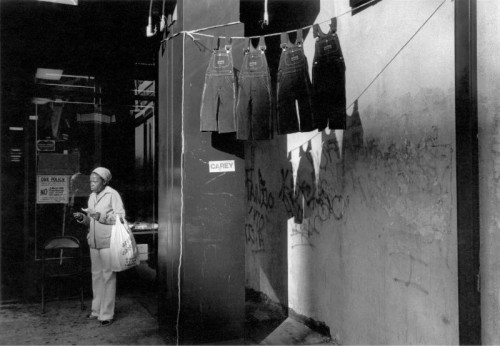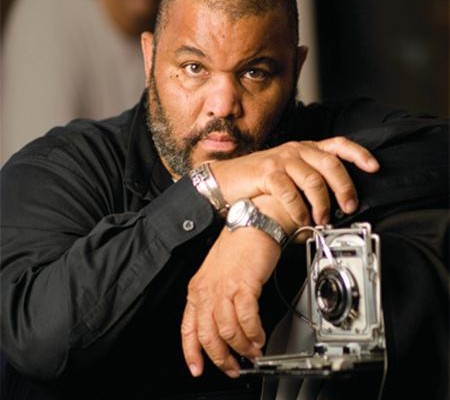Contributed by Kalamazoo Institute of Arts
 The Kalamazoo Institute of Arts will open a new exhibition January 13 – two suites of photographs by the Chicago-based artist Dawoud Bey. Harlem, USA (1975-1979) andHarlem Redux (2014-2017) together show the legendary Manhattan neighborhood at two points in time, one via black-and-white portraits, and the other via color images of the changing neighborhood landscape. The exhibition continues through April 11.
The Kalamazoo Institute of Arts will open a new exhibition January 13 – two suites of photographs by the Chicago-based artist Dawoud Bey. Harlem, USA (1975-1979) andHarlem Redux (2014-2017) together show the legendary Manhattan neighborhood at two points in time, one via black-and-white portraits, and the other via color images of the changing neighborhood landscape. The exhibition continues through April 11.Exhibition programming
*Dawoud Bey will present an Artist’s Talk at the Kalamazoo Institute of Arts on Thursday, March 22, at 6:30 pm, admission $5
*Dawoud Bey will jury the annual West Michigan Area Show, opening May 26, with entries due by April 8.
Details on all these events are available at kiarts.org.
Bey’s exploration of everyday urban life early in his career became his landmark Harlem, USA series, which premiered at the Studio Museum of Harlem in 1979 when he was just 26. Harlem Redux marks Bey’s return to the community 35 years later. The series comprises large-format color photos reflecting the transition of the celebrated community as it becomes more gentrified and its history more diverse.
“This is the first time that the two Bey series have been shown side by side,” says Tate. “Each reveals the beauty and candor of the community, and the exhibition not only explores Harlem, but inspires personal reflection on our own community, the people, buildings and pattern of activities that make ‘place’ matter. The exhibit allows us to reflect thoughtfully on the beauty and transitions evident in our own community and how we define a sense of place.
Dawoud Bey (b. 1953) began making photographs at age 16, after seeing the work of James Van Der Zee, who spent decades chronicling the people of Harlem. It was the elder photographer’s Harlem on My Mind exhibition at the Metropolitan Museum of Art that inspired Bey’s understanding that the black community could be the subject of a museum exhibition.
Bey began traveling from his home in Queens to explore the neighborhood that held such history for the country, for black people, and for his family, recalling that his parents had met and lived in Harlem, and family trips there had fascinated him. He became enamored with the vibrancy of Harlem and sought to capture the unique rhythms of life there in his pictures.
While Harlem, USA consists of grayscale portraits and street scenes, Harlem Reduxfocuses on the architecture and changing landscape of Harlem with an eye on the effects of gentrification, using large-format color photography to capture a community that Bey has said he felt was losing some of its identity and growing more generic.
As both James Van Der Zee and Bey gave voice to a marginalized community and fought the stereotypes of black life, the KIA exhibition will include images from the KIA holdings of 19 James Van Der Zee photographs, dating between 1900 and 1940.
“Both Van Der Zee and Bey are important in the history of American photography, given their ground-breaking and influential works,” says KIA Executive Director Belinda Tate. “Van Der Zee was one of the first to not only challenge stereotypes but also give us positive and empowering images of African Americans and one of the few to document the history of an African-American community over several decades.”
Of his Harlem, USA series, Bey said in a 2016 interview in Sixty Inches from Center, “Harlem occupies a large place in the black cultural imagination as the site of the Harlem Renaissance and significant black social, political, and cultural history. Harlem, USA was made as both a way of reconnecting to that family history and also to add something to the ongoing culture production and visualization of Harlem.”
Bey went on to say of his later series, “In Harlem Redux, I wanted to talk about the physical place, how it’s changing, and how place is connected to memory. Since the landscape of Harlem is changing so rapidly, I wanted to describe what that looks like while it’s taking place. Within this change, the long-time population of Harlem is being increasingly marginalized or disappeared, if you will. The absence of people and their diminished presence is deliberate, literally and metaphorically … I had to devise a conceptual and formal language that spoke to this current set of circumstances as they are happening; a language that speaks to the ideas of memory, absence, loss, and change.
Dawoud Bey holds an MFA in photography from Yale University and is a professor of art at Columbia College, Chicago, where he has taught since 1998. His work has been exhibited worldwide at institutions including the National Portrait Gallery, London, the Whitney Museum of American Art, the Art Institute of Chicago, the Cleveland Museum of Art, and the Los Angeles County Museum of Art. Bey is the recipient of fellowships from the Guggenheim Foundation and the National Endowment for the Arts, and in October 2017, he was named a MacArthur Foundation Fellow.
The Harlem, USA portion of this exhibition project is organized by art2art Circulating Exhibitions. TheHarlem Redux series of photographs is provided wiht the assistance fo Stephen Daiter Gallery, Chicago. The exhibition is supportes by a legacy gift from David & Muriel Gregg.
More about the artist
Born in New York City, Dawoud Bey began his career as a photographer in 1975 with a series of photographs, Harlem, USA, that was exhibited in his first solo exhibition at the Studio Museum in Harlem in 1979. He has since had exhibitions worldwide, at institutions including the Art Institute of Chicago, the Barbican Centre in London, the Cleveland Museum of Art, the Los Angeles County Museum of Art, the Detroit Institute of Arts, the High Museum of Art in Atlanta, the National Portrait Gallery in London, and the Whitney Museum of American Art.
His photographs are in numerous collections in this country and abroad. The Walker Art Center organized a mid-career survey of his work, Dawoud Bey: Portraits 1975-1995, that traveled throughout the United States and Europe. A major publication of the same title was also published in conjunction with that exhibition.
Class Pictures: Photographs by Dawoud Bey was published by Aperture in 2007. Aperture also traveled that exhibition to various museums around the country through 2011. Harlem, USA was published by Yale University Press in May 2012, in conjunction with the Art Institute of Chicago, where the work was exhibited in its entirety for the first time since it was shown at the Studio Museum in Harlem in 1979. Bey’s critical writings on photography and contemporary art have appeared in numerous publications and exhibition catalogs.
Bey’s recent work includes “Birmingham: Four Girls and Two Boys,” a project that features photographic pairings that freshly frame the tragic events surrounding the 1963 bombing of the 16th Street Baptist Church in Birmingham, Alabama. The project presents portraits of citizens of contemporary Birmingham; it offers children the same ages as those who died, coupled with adults who are the ages the children would have reached had they lived. The museum published a catalogue, The Birmingham Project, in 2013.
About the Kalamazoo Institute of Arts
The Kalamazoo Institute of Arts believes the visual arts are for everyone, and that they inspire, transform, and fulfill. Since 1924, the KIA, a private non-profit organization, has presented opportunities to the community and visitors from around the world to enjoy and create art. The KIA holds more than 4,700 fine artworks in its permanent collection; presents touring and collection exhibitions in 10 galleries; offers four terms of art classes at the Kirk Newman Art School; and houses the KIA Gallery Shop, featuring artwork by area artists and international artisans.
TOP: Dawoud Bey, A Woman with Hanging Overalls, 1978, silver gelatin print. ©Dawoud Bey. Courtesy of the artist
BELOW: Dawoud Bey, Loft Hotel, 2014, silver gelatin print. ©Dawoud Bey. Courtesy of Stephen Daiter Gallery, Chicago

